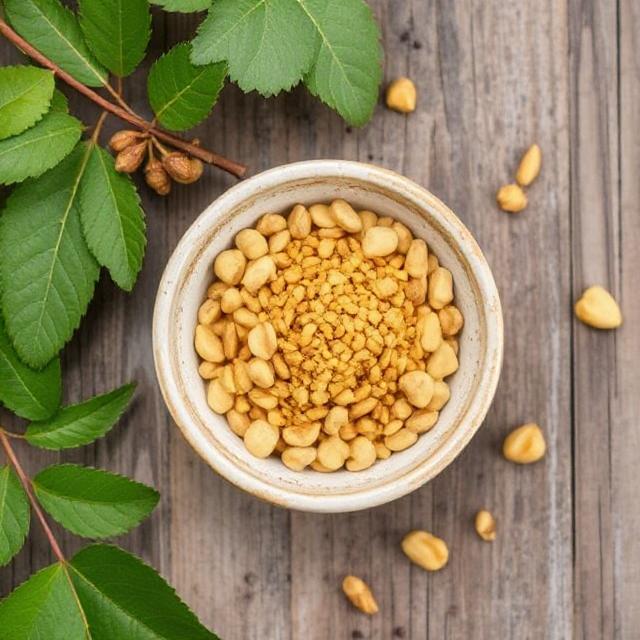Ashwagandha (Withania somnifera), Nature’s Ancient Adaptogen with Modern Relevance
Imagine a small, unassuming shrub growing in the dry soils of India, its roots holding secrets that have traveled through centuries of traditional medicine. This plant is Ashwagandha (Withania somnifera), often called “Indian ginseng” or “winter cherry.” Belonging to the Solanaceae family, it thrives in India, the Middle East, and parts of Africa. With dull green leaves, yellow flowers, and red berries, it may not appear extraordinary, but its roots are what have earned it a legendary reputation in Ayurveda. The Sanskrit name “Ashwagandha” means “smell of a horse,” hinting at both its distinct aroma and the strength and vitality it is believed to impart.
In a world increasingly filled with stress, fatigue, and lifestyle-related illnesses, Ashwagandha has re-emerged as one of the most sought-after natural remedies. From calming anxiety and boosting energy to improving sleep and supporting immunity, it has been praised for centuries as a rejuvenating herb. Today, modern science is catching up, validating what ancient healers already knew — Ashwagandha is not just a plant, but a holistic health ally. This is why learning about Ashwagandha is more important than ever: it bridges tradition with science, offering natural solutions to modern-day challenges.
7 Best Alternatives to Ashwagandha (Withania somnifera)
When Ashwagandha is unavailable or someone seeks alternatives with similar benefits, nature offers many options. Here are seven noteworthy ones:
- Shatavari (Asparagus racemosus) – India
Known as the “Queen of Herbs” in Ayurveda, Shatavari is valued for its adaptogenic and rejuvenating qualities, especially for women’s health. Native to India and the Himalayas, it is used for hormonal balance, digestive health, and overall vitality. - Ginseng (Panax ginseng) – East Asia
Often compared to Ashwagandha, ginseng is a famous adaptogen from China and Korea. It boosts stamina, supports immunity, and improves mental clarity. While Ashwagandha is grounding and calming, ginseng is considered more stimulating. - Rhodiola (Rhodiola rosea) – Siberia & Northern Europe
This hardy herb grows in cold regions and is renowned for fighting fatigue, enhancing resilience, and improving mental focus. Rhodiola is often used by students, athletes, and those in high-stress professions. - Holy Basil (Tulsi, Ocimum sanctum) – India
Sacred in Indian households, Tulsi is both a spiritual and medicinal plant. It helps combat stress, supports immunity, and balances the body. Unlike Ashwagandha’s earthy qualities, Tulsi adds a refreshing, uplifting touch. - Maca Root (Lepidium meyenii) – Peru
Grown high in the Andes mountains, maca is celebrated for enhancing energy, libido, and endurance. Similar to Ashwagandha, it is used for vitality and hormonal balance, but it carries a sweet, nutty taste. - Licorice Root (Glycyrrhiza glabra) – Mediterranean & Asia
A well-known herb in Ayurveda and Traditional Chinese Medicine, licorice supports adrenal health, reduces inflammation, and aids digestion. It is often used alongside Ashwagandha in herbal formulations. - Eleuthero (Eleutherococcus senticosus) – Russia & China
Also known as Siberian ginseng, eleuthero is another adaptogen that enhances stamina and strengthens the body against stress. It has been traditionally used to increase work performance and immune resilience.
When and Where
When is Ashwagandha harvested or used?
Traditionally, Ashwagandha roots are harvested in late winter, once the plant has matured and stored its energy underground. This timing ensures potency, as roots harvested too early lack the same strength. For centuries, healers advised consuming Ashwagandha during colder months to nourish the body, improve immunity, and protect against seasonal weakness.
Where is it found or cultivated?
Though native to India, Ashwagandha is also found in parts of the Middle East, Nepal, and Africa. It grows well in dry, stony soils and can withstand drought-like conditions. Today, India remains the largest cultivator, particularly in states like Madhya Pradesh, Rajasthan, and Uttar Pradesh, where traditional farming blends seamlessly with modern herbal industries.
How is it sourced or prepared?
Traditionally, roots are cleaned, dried, and ground into powders. Leaves and berries, though less common, are also used in certain remedies. In villages, decoctions (kashayas) were prepared, while in modern herbal shops, you’ll find Ashwagandha as capsules, tinctures, or teas.
Who traditionally uses it?
Ayurvedic healers, Siddha practitioners, and Unani medicine doctors have all employed Ashwagandha in their systems of healing. Beyond physicians, Indian households often prepared simple Ashwagandha remedies at home — such as mixing its powder in milk before bed for better sleep and strength.
Which varieties or related species exist?
The most widely used is Withania somnifera, but related plants like Withania coagulans (Indian rennet) have been traditionally used for digestive and coagulating purposes. However, somnifera remains the gold standard in medicine and research.
Who Uses Ashwagandha (Withania somnifera)?
Ashwagandha has a long legacy across diverse communities. In India, it has been part of Ayurveda for over 3,000 years, recommended for kings, warriors, and householders alike. Yogis took it to improve stamina and focus, while householders valued it for general vitality. In Unani medicine, it was used for joint pain, sexual health, and general debility.
Today, it has traveled far beyond its traditional borders. Western herbalists recommend it as a natural stress-relief supplement. Athletes use it to enhance endurance, office workers for managing anxiety, and older adults for cognitive support. Ashwagandha has become a true global herb, valued by diverse people for different needs.
Why Use Ashwagandha (Withania somnifera)?
People turn to Ashwagandha for several reasons:
- Stress & Anxiety Relief: As an adaptogen, it helps regulate cortisol and calm the nervous system.
- Energy & Stamina: Unlike stimulants, Ashwagandha provides steady, sustainable energy.
- Sleep Support: It is often recommended for insomnia and restlessness.
- Immunity: Strengthens the body’s resistance to infections.
- Cognitive Health: Improves memory, focus, and mental clarity.
- Hormonal Balance: Supports fertility, reproductive health, and thyroid function.
Culturally, Ashwagandha is also seen as a rasayana — a rejuvenating herb that enhances both body and mind, extending longevity and vitality.
Which Parts of Ashwagandha Are Used?
While the roots are most commonly used in Ayurvedic medicine, other parts have unique applications:
- Roots: Used for powders, tonics, and extracts to boost strength and reduce stress.
- Leaves: Sometimes applied externally for swelling and pain relief.
- Berries: Traditionally used in some folk medicines but less popular today.
- Seeds: Rarely used but occasionally included in formulations.
Each part contributes differently, but the root remains the star.
How to Use Ashwagandha (Withania somnifera)?
Ashwagandha can be consumed in many ways depending on tradition and modern convenience:
- Powder (Churna): Mixed in warm milk or honey for sleep and vitality.
- Capsules/Tablets: Modern and convenient for daily use.
- Tea/Decoction: Simmered roots create a calming herbal tea.
- Extracts/Tinctures: Concentrated forms for targeted benefits.
- External Applications: Leaves crushed into poultices for swelling or skin issues.
Precaution: While generally safe, it should be avoided in high doses during pregnancy, and those on medication should consult a healthcare provider to prevent interactions.
Important Facts About Ashwagandha
- Botanical Details: Belongs to the Solanaceae family, related to tomatoes and eggplants.
- Key Compounds: Withanolides, alkaloids, and saponins are responsible for its medicinal action.
- Research Insights: Studies show its effectiveness in reducing cortisol, improving sleep, and supporting thyroid and reproductive health.
- Potential Side Effects: High doses may cause stomach upset, drowsiness, or interactions with thyroid and sedative medications.
- Modern Popularity: Now included in energy drinks, supplements, protein powders, and wellness teas globally.
FAQs on Ashwagandha (Withania somnifera)
1. Is Ashwagandha safe to use daily?
Yes, in moderate amounts it is safe and beneficial, but consult a doctor if you have medical conditions.
2. Can Ashwagandha help with anxiety and stress?
Yes, it’s one of the most studied herbs for stress relief, thanks to its adaptogenic properties.
3. Where can I buy Ashwagandha?
It is widely available in Ayurvedic shops, health food stores, and online marketplaces globally.
4. How fast does Ashwagandha work?
Some people notice effects within a few days, but consistent use for 4–6 weeks gives best results.
5. Does Ashwagandha interact with medications?
Yes, it may interact with sedatives, thyroid medicines, or blood pressure drugs — consult your doctor.
6. Can Ashwagandha improve fertility?
Yes, traditionally it has been used for reproductive health, and studies suggest it can improve sperm quality and hormonal balance.
7. Is Ashwagandha good for athletes?
Absolutely. It helps with endurance, recovery, and strength without the crash of stimulants.
Conclusion
Ashwagandha is more than just an herb; it is a bridge between ancient wisdom and modern science. For centuries, it has been a trusted companion in Ayurveda, offering strength, balance, and rejuvenation. Today, as stress and fatigue dominate our fast-paced lives, Ashwagandha has found new relevance across the globe.
Its ability to calm the mind while energizing the body makes it unique among natural remedies. Whether used as a nightly tonic in warm milk, a capsule for busy professionals, or an extract for athletes, Ashwagandha adapts to every lifestyle.
But like all powerful herbs, it must be used with respect and awareness. Explore it, learn about it, and let it support your health — but always responsibly. In Ashwagandha, nature has given us a gentle yet profound reminder that true healing often lies in roots, both botanical and cultural.


